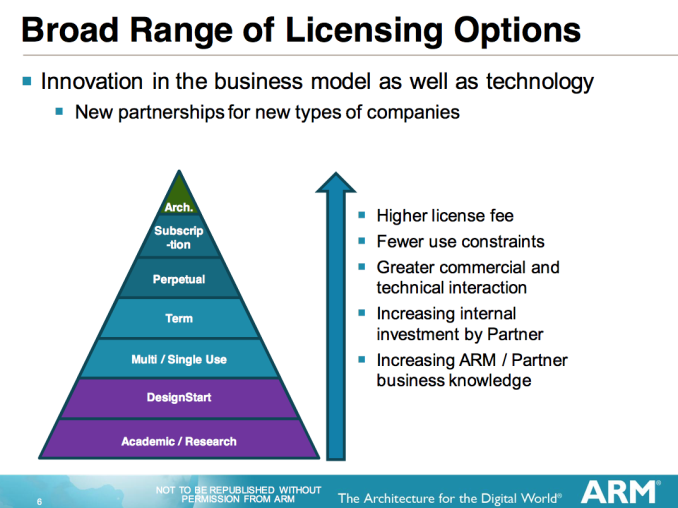The ARM Diaries, Part 1: How ARM’s Business Model Works
by Anand Lal Shimpi on June 28, 2013 12:06 AM ESTTypes of License
Although I wrote about there being three high level license types (processor, POP and architectural) in reality there’s a spectrum of options that ARM offers.
Academic licenses are effectively free. You can’t sell any designs but it’s a great way to build familiarity with an architecture. DesignStart is a low cost option for an academic/research arm of a company. Again, neither of these designs can be sold which is why the up front fee is very low/effectively zero.
ARM offers single use licenses for companies who just need a particular core for a single project (e.g. I want to build a single design based on the Cortex A9). A single use license for a Cortex A-class CPU will be somewhere around $1M up front plus ~2% per chip sold. The single use licenses are really useful for startups or very specific design needs within a company.
Multi-use licenses make a bit more sense for larger companies with multiple products. Here you get a larger up front fee but you can use your licensed CPU design within any number of products within a certain period of time (e.g. 3 years). During that time frame you can design as many products as possible, but you cannot begin any new designs after the 3 year period ends without a license renewal.
Perpetual multi-use licenses are more common in larger companies. These allow the licensee to use a core in any number of devices, indefinitely. As some ARM licensees can keep the same core in use for 10 - 20 years (particularly in industrial applications), the perpetual multi-use license gets a fair bit of use.
The subscription license is quite possibly the most interesting out of the pyramid. Companies can purchase a subscription license to ARM’s entire portfolio of products, for a set number of years. What a subscription license really enables is engineering managers within a company to start a chip project without having to worry about asking for budget for a large up front license fee since the company as a whole has already paid it. The up front fee here is multiple times the $10M top end for a standard part, for obvious reasons.
Finally at the top of the pyramid is an ARM architecture license. Marvell, Apple and Qualcomm are some examples of the 15 companies that have this license.
The Chosen Three
Since ARM doesn’t actually make any chips of its own, it needs to ensure that for each generation there are launch partners that will produce designs based on the latest and greatest. For each new microprocessor IP, ARM chooses up to three partners to work very closely with. The reason for choosing three is to hopefully work with companies targeting multiple markets. We tend to focus on the high-end smartphone/tablet SoC space here, but ARM architectures find their way into industrial, digital home, TV and other markets as well.
These companies get earlier access than any other licensee to whatever new microarchitecture ARM is working on. The licensees in exchange help debug and test the IP, even providing feedback directly to ARM. The benefit to the licensee is the potential for a significant time to market advantage on the new microarchitecture.











64 Comments
View All Comments
3dcgi - Sunday, June 30, 2013 - link
Anand, do you have info on how the cost of an architecture license differs from a regular IP license? I assume it's a higher upfront license cost and lower royalty cost, but haven't seen this specified anywhere. Thanks.hazydave - Tuesday, July 2, 2013 - link
I actually wonder how much of Intel's fortune is really within their control anymore. On the one hand, it's hard to imagine why Intel, the only company really making a consumer-oriented CPU selling retail at about $1,000 every year, working so hard to match price, power, and performance against a market based on SOC's that OEM at $15.On the other hand, Intel's superpower has always been cash, and cash has always depended on volume. Intel clearly sees the Windows marketing contracting, and feels they need to make the jump to whatever's next. Android can of course run on Intel, it's actually been a standard thing for the last few versions. And that could be key... it's expected about 850 million Android devices ship this year, versus about 350 million Windows devices. Not as much cash, clearly, but it does suggest that this doesn't have to happen for too many years in a row to see Android going to replace most of the desktop uses, and desktops becoming niche.
Intel did a pretty good job destroying every niche processor within range of the x86. SPARC and Power still hang on at the high end, AMD used their x86-64 to kill off Intel's IA-64 (ok, sure, Intel helped a lot there too). MIPS and PowerPC are mitigated to embedded... only ARM is a primary application processor against Intel (and occasionally AMD) these days.
But Intel's definitely risking getting dragged down with Microsoft. Maybe Microsoft will bounce back on better x86s, maybe not. Intel doesn't seem willing to take that risk, and you can't exactly blame them.
goo.gle - Saturday, July 20, 2013 - link
Give us the next one already! :DEN10 - Thursday, August 8, 2013 - link
Looks like Charlie Demerjian is taking your images & article notes and putting his stamp on them. Bit naughty, or just a coincidence?http://semiaccurate.com/2013/08/07/a-long-look-at-...
http://semiaccurate.com/2013/08/08/how-arm-license...